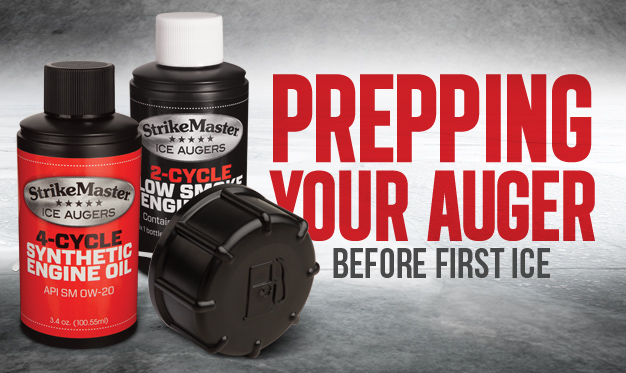Before your yard’s last mow this fall, fill your LawnBoy with the gas left in your StrikeMaster auger.
“When the days shorten and the nights chill, that’s my cue to feed my old auger gas to the lawnmower and weed whipper,” says ICE FORCE Pro James Holst, host of In-Depth Outdoors TV on the Fox Sports North channel. “I don’t care if they don’t run. If they don’t, I might get out of some yard work!”
He’s only half-kidding. But when it comes to his ice augers, Holst is serious. He does care if they run – and run well. So he takes precautions to assure they do.
“I don’t want to risk running six-month old gas through my augers right before the ice season starts, in the off chance that the gas went bad,” says Holst, who stores his 4-stroke StrikeMaster Honda 35cc Lite [Product 'Honda%2035cc%20Lite' not found!] and his StrikeMaster Lazer Pro [Product 'Lazer%20Pro' not found!] over the off-season with quarter-tanks of gas mixed with fuel stabilizer. “Storing them with some gas in the tank helps prevent my carburetor needles from sticking open or shut and other carb components from drying out, warping, swelling or cracking.”
Holst considers it a must to replace that old gas before hitting the ice for the first time. He funnels it into a hand-held dispenser or directly into the tanks of his lawnmower and weed whipper, if there’s room.
He then fills his auger tanks with fresh, premium gas, adding oil to the 2-stroke’s tank (40:1 gas-to-oil ratio). Next, he changes the oil in his 4-stroke with a 3.4 oz. bottle of Strikemaster Synthetic 0W-20 [Product '0W-20' not found!]. To drain the old oil, remove the oil plug and tip the auger over a catch pan.
“I turn the auger upside down, prop it so its steady and draining oil into the pan and then I walk away,” Holst says. “I’ve got better things to do than watch the last couple drops of oil drip, drip, drip out of the crankcase, so I usually allow about 15 minutes for everything to drain, which frees me up to get other ice gear ready to go.”
After he’s replaced gas and oil, Holst test-runs each auger. If they don’t start quickly and run smoothly, he’ll change spark plugs.
“Which is about the extent of the mechanical prowess I find I need to expend to get a StrikeMaster to run like a champ,” he says. “Give them high-quality fuel and a good spark plug and they are as reliable as the sunrise.”
Once Holst has his augers running smoothly, he’ll inspect every exposed nut, bolt and screw head with the appropriate fastener to ensure the entire assembly – from powerhead to cutting blades – are torqued properly.
“Ten minutes spent making sure nothing wiggled loose last winter while punching hole number 9,278 is time well spent,” Holst says. “Finding a medium-sized Phillips-head screwdriver out in the middle of Mille Lacs Lake pre-dawn can represent a bit of a challenge. And I’m not losing fishing time over a loose fastener.”
Finally, Holst will inspect his blades, which he protected with oil before storing his augers.
“I expect everything to be in good working order since I put the auger to bed that way,” he says. “What I’m looking for is any damage caused over the summer that I’m not aware of – Did the auger cover stay in place? If not, did something hit the blades? Did the blades hit the garage floor? I’m looking for dings and any sign that the blades suffered an impact.”
If everything passes the visual test, Holst is confident his augers are good to go and he’s ready to hit the ice.
James Holst, founder, host and producer of In-Depth Outdoors TV, has caught more 10-pound plus walleyes live on camera than most will catch in a lifetime. He began teaching fishing as a fulltime guide, spending more than 250 days a year on the the Upper Mississippi River as well as track and hook walleyes in Minnesota’s Lake Mille Lacs. In 2000, he lauched his In-Depth Outdoors website. In 2006, he launched In-Depth Outdoors TV.
